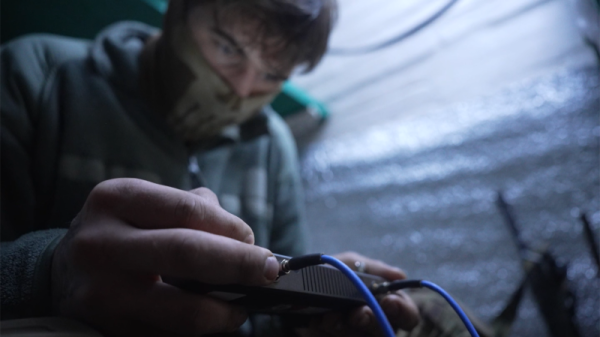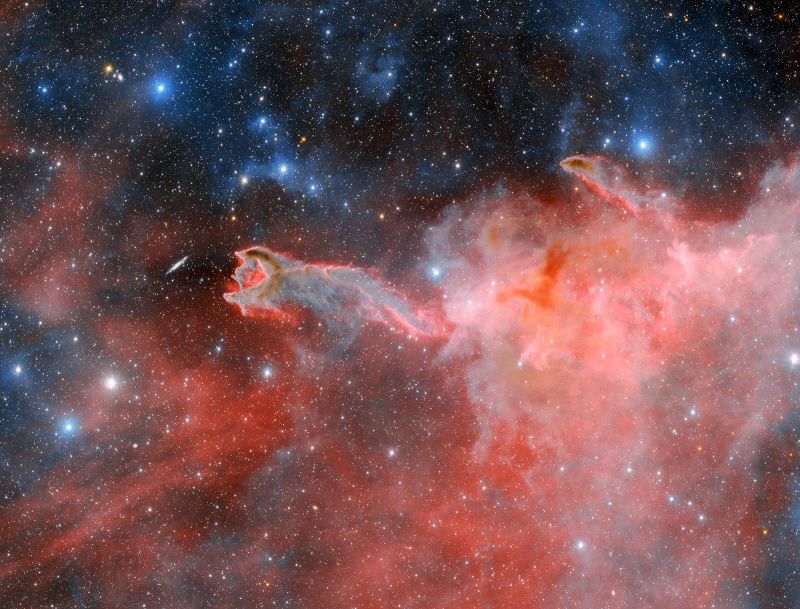What appears to be a ghostly hand reaching across the universe toward a defenseless spiral galaxy in a new telescope image is a rarely seen cosmic phenomenon, according to astronomers.
The Dark Energy Camera captured a stunning image of “God’s Hand,” a cometary globule 1,300 light-years from Earth in the Puppis constellation. The camera is mounted on the Víctor M. Blanco 4-meter Telescope at Cerro Tololo Inter-American Observatory in Chile.
Cometary globules are a type of Bok globule, or dark nebula. These isolated cosmic clouds are filled with dense gas and dust, which are surrounded by hot, energetic material. Cometary globules are unique because they have extended tails, like those seen on comets — but that’s the only cometlike thing about them.
Astronomers still don’t know how cometary globules come to exist in such distinctive structures. Historically, it’s also been hard for scientists to detect the faint clouds.
The new image of the glowing red hand-like feature showcases CG 4, one of many cometary globules found across the Milky Way galaxy. The twisting cloud appears to be reaching for a spiral galaxy known as ESO 257-19 (PGC 21338). But the galaxy is more than 100 million light-years away from the cometary globule.
CG 4 has a main dusty head, which resembles a hand, that measures 1.5 light-years across, and it has a long tail that stretches for 8 light-years. A light-year is the distance light travels in one year, which is 5.88 trillion miles (9.46 trillion kilometers).
A surprising celestial discovery
Astronomers first discovered cometary globules by chance in 1976 while looking at images captured by the UK Schmidt Telescope in Australia. These cosmic phenomena are hard to spot because they’re incredibly faint, and the tails of globules are typically blocked from view by stellar dust.
But the Dark Energy Camera has a special filter that can detect the incredibly dim red glow emitted by ionized hydrogen, which is present in the outer rim and head of CG 4. Hydrogen only produces such a telltale red glow after being hit with radiation from nearby hot, massive stars.
While stellar radiation enables the cometary globule to be visible, it is also destroying the globule’s head over time. However, there is enough gas and dust within the globule to aid in the birth of several stars the size of our sun.
Cometary globules can be found across our galaxy, but most are in the Gum Nebula, a glowing cloud of gas believed to be the slowly expanding remains of a stellar explosion from about 1 million years ago. The Gum Nebula is believed to contain 31 cometary globules in addition to CG 4.
Astronomers think there are a couple of ways that the globules may form their distinctive, cometlike shapes.
The globules might have once been round-shaped nebulas, such as the iconic Ring Nebula, that were disrupted over time by a supernova — maybe even the one that formed the Gum Nebula.
But the cosmic phenomena may also be the result of the winds and radiation released from nearby hot, massive stars.
Astronomers believe stars might be the underlying cause because all the cometary globules found in the Gum Nebula have tails pointing away from the nebula’s center. And at the center of the nebula is the supernova remnant as well as a pulsar, or a rapidly spinning neutron star that formed when a much larger star collapsed and exploded.


































